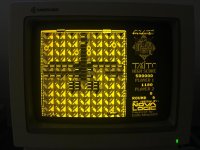dr.zeissler
Experienced Member
Hi,
I am currently using my old and first PC again. It's the only PC that was called "kind of homecomputer-style-machine" because of it's design. In the past I hated it, because I got it with a CGA Monitor that has the ugly CGA colors/palettes in gfx-mode and no real high resolution (above 640x200) while my friends had C128D, A500, MegaST1. So no chance for me and my 8088/CGA/Beeper Machine
Now I am looking different to that machine. It's a really nice one, quiet and with great design.
I could have use CGA again, but currently Hercules is the better choice in my opinion. Games look better in Hercules then in CGA, even if thy are emulated through software. And the High-Res Mode of Hercules is quite usefull in Windows, Gem, Geoworks etc. So I startet to collect software for the machine and there is lot's of stuff for it
Even in 2016 someone released a very nice Hercules-Demo that is also shown in my video.
Games with native Hercules-Support according to trixter's mobygames: http://www.mobygames.com/browse/games/dos/tic,2/ti,4/
Games with native CGA-Support according to trixter's mobygames: http://www.mobygames.com/browse/games/dos/tic,2/ti,1/
Currently I am at the point to search for the best CGA-Emulator for a CGA-Only game. Most games do work with my favorite CGA-Emulator "EMU", but If the game uses or falls back to textmode, then this emulator is useless, because it can do no fallback in textmode. Therefore quitting a game leads to a reboot. The main Problem of CGA-Emulation on Hercules with an XT-Class Computer is getting a good picture with a propper animation speed. Mainly this means using an CGA-Emulator that does some kind of Scanlines (but there are no real scanlines, to me it looks like two lines drawn and then a black line) and a sharp animation. Using no black-lines means getting "ghosting" on the animation.
A have collected a bunch of CGA-Emulators but mustly I use "EMU" because it's fast and delivers a centered Picture on my machine. But as I wrote before, some games do not work with it and some CGA-Titles do not work with any CGA-Emulator I have collected so far. I am pretty sure that Hercules Gaming can be optimized by finding the best CGA-Emulator for each Game. Tweaking to get the best result should be the goal.
Thx Doc
Some pictures of my machine: https://www.flickr.com/photos/94839221@N05/albums/72157665135854734
I am currently using my old and first PC again. It's the only PC that was called "kind of homecomputer-style-machine" because of it's design. In the past I hated it, because I got it with a CGA Monitor that has the ugly CGA colors/palettes in gfx-mode and no real high resolution (above 640x200) while my friends had C128D, A500, MegaST1. So no chance for me and my 8088/CGA/Beeper Machine
Now I am looking different to that machine. It's a really nice one, quiet and with great design.
I could have use CGA again, but currently Hercules is the better choice in my opinion. Games look better in Hercules then in CGA, even if thy are emulated through software. And the High-Res Mode of Hercules is quite usefull in Windows, Gem, Geoworks etc. So I startet to collect software for the machine and there is lot's of stuff for it
Even in 2016 someone released a very nice Hercules-Demo that is also shown in my video.
Games with native Hercules-Support according to trixter's mobygames: http://www.mobygames.com/browse/games/dos/tic,2/ti,4/
Games with native CGA-Support according to trixter's mobygames: http://www.mobygames.com/browse/games/dos/tic,2/ti,1/
Currently I am at the point to search for the best CGA-Emulator for a CGA-Only game. Most games do work with my favorite CGA-Emulator "EMU", but If the game uses or falls back to textmode, then this emulator is useless, because it can do no fallback in textmode. Therefore quitting a game leads to a reboot. The main Problem of CGA-Emulation on Hercules with an XT-Class Computer is getting a good picture with a propper animation speed. Mainly this means using an CGA-Emulator that does some kind of Scanlines (but there are no real scanlines, to me it looks like two lines drawn and then a black line) and a sharp animation. Using no black-lines means getting "ghosting" on the animation.
A have collected a bunch of CGA-Emulators but mustly I use "EMU" because it's fast and delivers a centered Picture on my machine. But as I wrote before, some games do not work with it and some CGA-Titles do not work with any CGA-Emulator I have collected so far. I am pretty sure that Hercules Gaming can be optimized by finding the best CGA-Emulator for each Game. Tweaking to get the best result should be the goal.
Thx Doc
Some pictures of my machine: https://www.flickr.com/photos/94839221@N05/albums/72157665135854734
Last edited:


